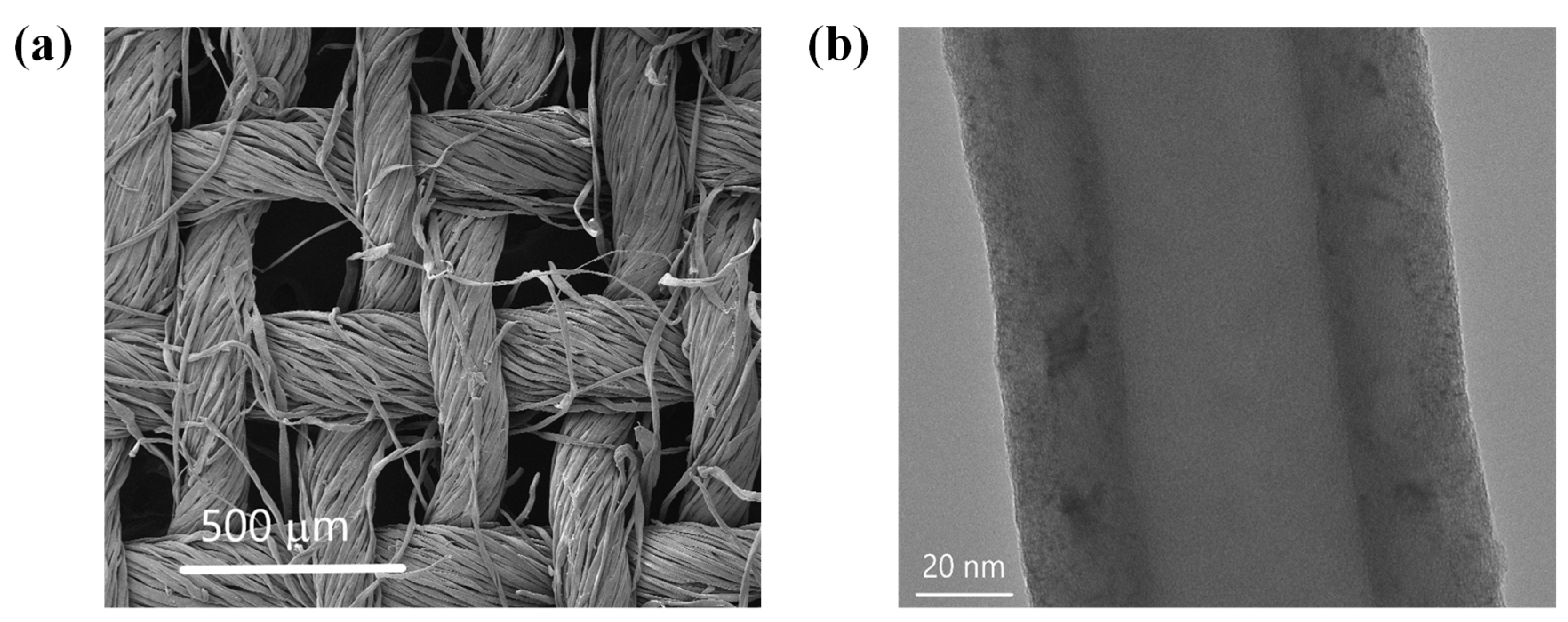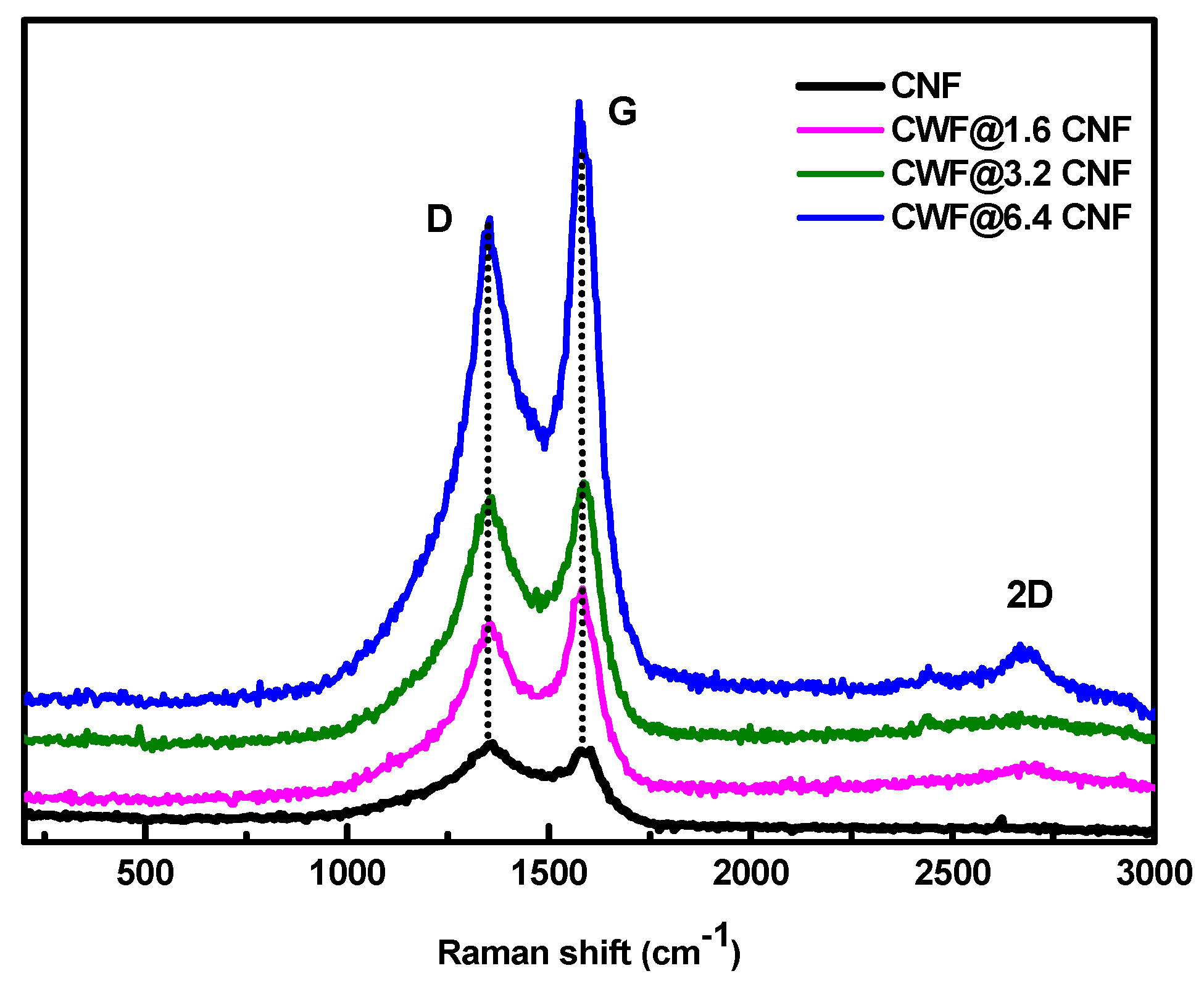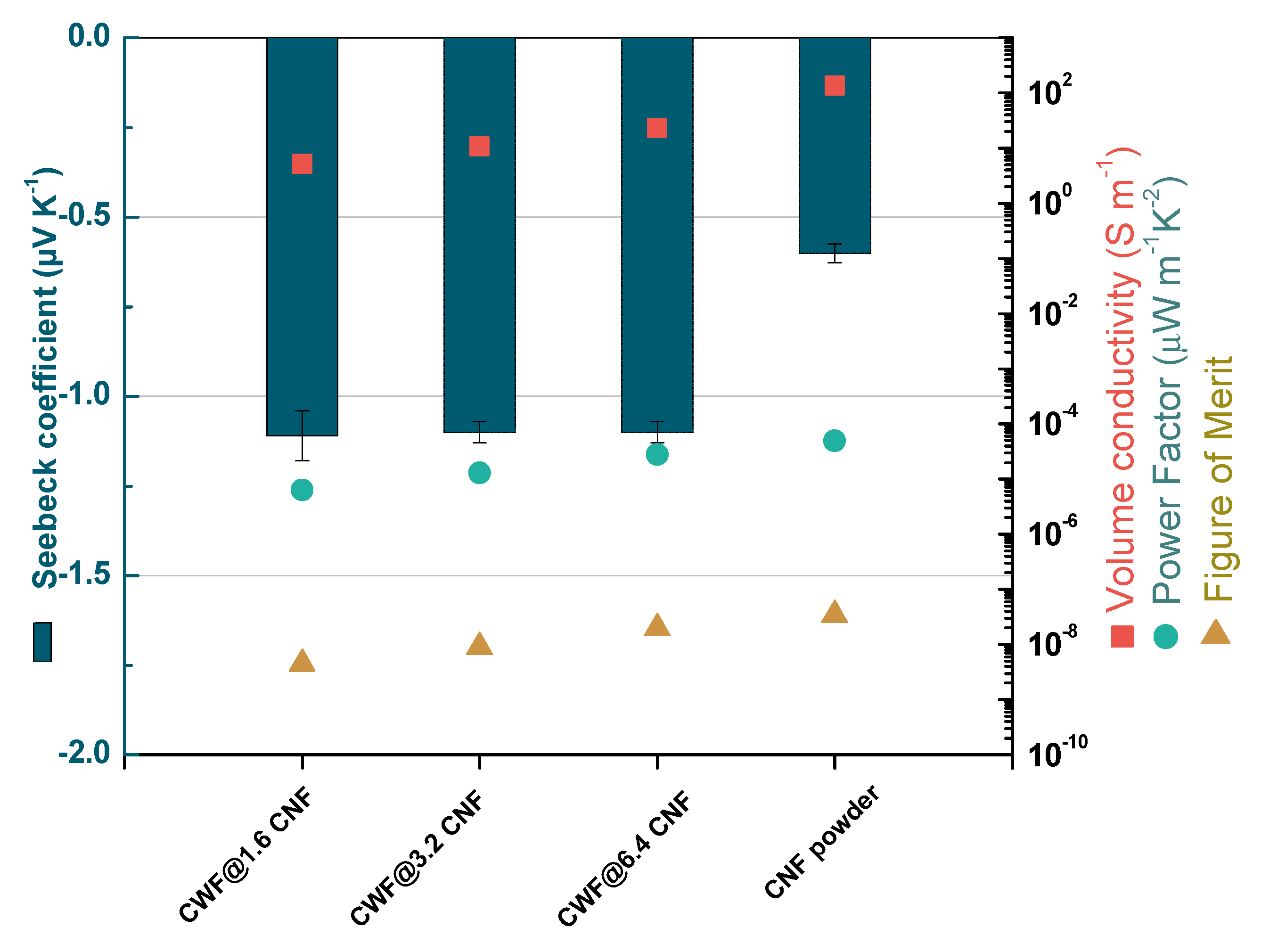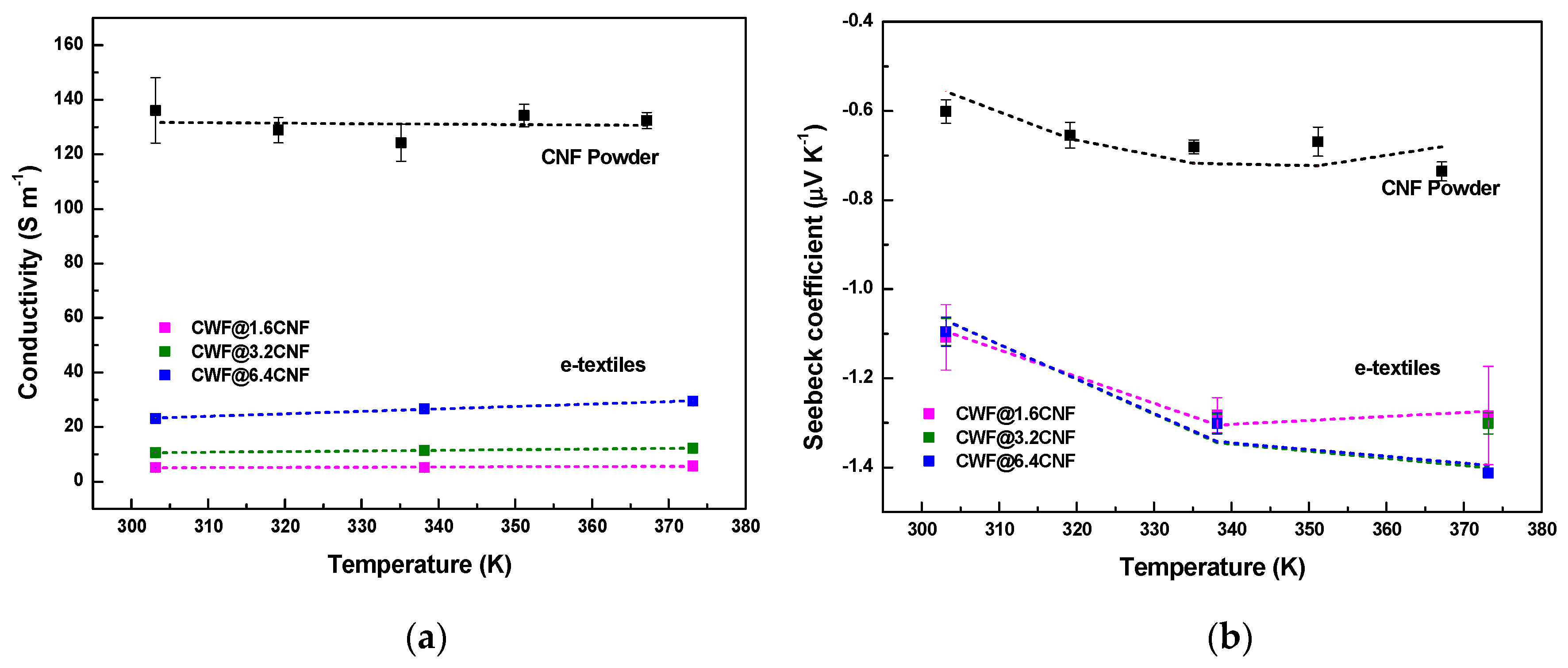Thermoelectric Properties of Cotton Fabrics Dip-Coated in Pyrolytically Stripped Pyrograf® III Carbon Nanofiber Based Aqueous Inks
Abstract
1. Introduction
2. Materials and Methods
2.1. Materials
2.2. Preparation of Conductive Textiles
2.3. Morphological and Structural Analysis
2.4. Thermoelectric Analysis
3. Results and Discussion
3.1. Morphological Analysis of As-Received CNFs and Dip-Coated Textiles
3.2. Raman Analysis of As-Received CNFs and Dip-Coated Textiles
3.3. XPS Analysis of As-Received CNFs and Dip-Coated Textiles
3.4. Thermoelectric Properties of As-Received CNFs and Dip-Coated Textiles at 30 °C
3.4.1. Electrical Conductivity
3.4.2. Seebeck Coefficient
3.4.3. Power Factor and Figure of Merit
3.5. Thermoelectric Properties of As-Received CNFs and Dip-Coated Textiles from 30 °C to 100 °C
3.5.1. Electrical Conductivity
3.5.2. Seebeck Coefficient
3.6. Electrical Conductivity σ (T) and Seebeck Coefficient S (T) Modeling of As-Received CNFs and Dip-Coated Textiles from 30 °C to 100 °C
3.6.1. Electrical Conductivity σ (T) Modeling
3.6.2. Seebeck Coefficient S (T) Modeling
4. Conclusions
Supplementary Materials
Author Contributions
Funding
Institutional Review Board Statement
Informed Consent Statement
Data Availability Statement
Conflicts of Interest
References
- Tseghai, G.B.; Malengier, B.; Fante, K.A.; Nigusse, A.B.; Van Langenhove, L. Integration of Conductive Materials with Textile Structures, an Overview. Sensors 2020, 20, 6910. [Google Scholar] [CrossRef] [PubMed]
- Lund, A.; Wu, Y.; Fenech-Salerno, B.; Torrisi, F.; Carmichael, T.B.; Müller, C. Conducting materials as building blocks for electronic textiles. MRS Bull. 2021, 46, 491–501. [Google Scholar] [CrossRef] [PubMed]
- Buga, C.S.; Viana, J.C. A Review on Materials and Technologies for Organic Large-Area Electronics. Adv. Mater. Technol. 2021, 6, 2001016. [Google Scholar] [CrossRef]
- Khair, N.; Islam, R.; Shahariar, H. Carbon-based electronic textiles: Materials, fabrication processes and applications. J. Mater. Sci. 2019, 54, 10079–10101. [Google Scholar] [CrossRef]
- Shao, W.; Cui, T.; Li, D.; Jian, J.; Li, Z.; Ji, S.; Cheng, A.; Li, X.; Liu, K.; Liu, H.; et al. Carbon-Based Textile Sensors for Physiological-Signal Monitoring. Materials 2023, 16, 3932. [Google Scholar] [CrossRef]
- Liao, Y.; Zhang, R.; Qian, J. Printed electronics based on inorganic conductive nanomaterials and their applications in intelligent food packaging. RSC Adv. 2019, 9, 29154–29172. [Google Scholar] [CrossRef] [PubMed]
- Islam, R.; Khair, N.; Ahmed, D.M.; Shahariar, H. Fabrication of low cost and scalable carbon-based conductive ink for E-textile applications. Mater. Today Commun. 2019, 19, 32–38. [Google Scholar] [CrossRef]
- Islam, M.R.; Afroj, S.; Novoselov, K.S.; Karim, N. Smart Electronic Textile-Based Wearable Supercapacitors. Adv. Sci. 2022, 9, 2203856. [Google Scholar] [CrossRef] [PubMed]
- Chatterjee, K.; Ghosh, T.K. Thermoelectric Materials for Textile Applications. Molecules 2021, 26, 3154. [Google Scholar] [CrossRef]
- Chen, G.; Li, Y.; Bick, M.; Chen, J. Smart Textiles for Electricity Generation. Chem. Rev. 2020, 120, 3668–3720. [Google Scholar] [CrossRef]
- Blackburn, J.L.; Ferguson, A.J.; Cho, C.; Grunlan, J.C. Carbon-Nanotube-Based Thermoelectric Materials and Devices. Adv. Mater. 2018, 30, 1704386. [Google Scholar] [CrossRef] [PubMed]
- Zevalkink, A.; Smiadak, D.M.; Blackburn, J.L.; Ferguson, A.J.; Chabinyc, M.L.; Delaire, O.; Wang, J.; Kovnir, K.; Martin, J.; Schelhas, L.T.; et al. A practical field guide to thermoelectrics: Fundamentals, synthesis, and characterization. Appl. Phys. Rev. 2018, 5, 021303. [Google Scholar] [CrossRef]
- Rowe, D.M. CRC Handbook of Thermoelectrics; CRC Press: Boca Raton, FL, USA, 1995. [Google Scholar]
- Paleo, A.J.; Vieira, E.M.F.; Wan, K.; Bondarchuk, O.; Cerqueira, M.F.; Bilotti, E.; Melle-Franco, M.; Rocha, A.M. Vapor grown carbon nanofiber based cotton fabrics with negative thermoelectric power. Cellulose 2020, 27, 9091–9104. [Google Scholar] [CrossRef]
- Paleo, A.J.; Krause, B.; Cerqueira, M.F.; Muñoz, E.; Pötschke, P.; Rocha, A.M. Electronic Features of Cotton Fabric e-Textiles Prepared with Aqueous Carbon Nanofiber Inks. ACS Appl. Eng. Mater. 2022, 1, 122–131. [Google Scholar] [CrossRef]
- Mott, N.F. Conduction in glasses containing transition metal ions. J. Non-Cryst. Solids 1968, 1, 1–17. [Google Scholar] [CrossRef]
- Choi, Y.M.; Lee, D.S.; Czerw, R.; Chiu, P.W.; Grobert, N.; Terrones, M.; Reyes-Reyes, M.; Terrones, H.; Charlier, J.C.; Ajayan, P.M.; et al. Nonlinear Behavior in the Thermopower of Doped Carbon Nanotubes Due to Strong, Localized States. Nano Lett. 2003, 3, 839–842. [Google Scholar] [CrossRef]
- Pyrograf Products Inc. Available online: https://apsci.com/products/pyrograf/ (accessed on 31 May 2023).
- Guadagno, L.; Raimondo, M.; Vittoria, V.; Vertuccio, L.; Lafdi, K.; De Vivo, B.; Lamberti, P.; Spinelli, G.; Tucci, V. The role of carbon nanofiber defects on the electrical and mechanical properties of CNF-based resins. Nanotechnology 2013, 24, 305704. [Google Scholar] [CrossRef]
- Jenschke, W.; Ullrich, M.; Krause, B.; Pötschke, P. Messanlage zur Untersuchung des Seebeck-Effektes in Polymermaterialien Measuring apparatus for study of Seebeck effect in polymer materials. Tech. Mess. 2020, 87, 495–503. [Google Scholar] [CrossRef]
- Gnanaseelan, M.; Chen, Y.; Luo, J.; Krause, B.; Pionteck, J.; Pötschke, P.; Qi, H. Cellulose-carbon nanotube composite aerogels as novel thermoelectric materials. Compos. Sci. Technol. 2018, 163, 133–140. [Google Scholar] [CrossRef]
- Krause, B.; Barbier, C.; Levente, J.; Klaus, M.; Pötschke, P. Screening of Different Carbon Nanotubes in Melt-Mixed Polymer Composites with Different Polymer Matrices for Their Thermoelectrical Properties. J. Compos. Sci. 2019, 3, 106. [Google Scholar] [CrossRef]
- Mahanta, N.K.; Abramson, A.R.; Lake, M.L.; Burton, D.J.; Chang, J.C.; Mayer, H.K.; Ravine, J.L. Thermal conductivity of carbon nanofiber mats. Carbon 2010, 48, 4457–4465. [Google Scholar] [CrossRef]
- Wang, Y.; Alsmeyer, D.C.; McCreery, R.L. Raman Spectroscopy of Carbon Materials: Structural Basis of Observed Spectra. Chem. Mater. 1990, 2, 557–563. [Google Scholar] [CrossRef]
- Lehman, J.H.; Terrones, M.; Mansfield, E.; Hurst, K.E.; Meunier, V. Evaluating the characteristics of multiwall carbon nanotubes. Carbon 2011, 49, 2581–2602. [Google Scholar] [CrossRef]
- Ferrari, A.C.; Basko, D.M. Raman spectroscopy as a versatile tool for studying the properties of graphene. Nat. Nanotechnol. 2013, 8, 235–246. [Google Scholar] [CrossRef] [PubMed]
- Endo, M.; Kim, Y.A.; Takeda, T.; Hong, S.H.; Matusita, T.; Hayashi, T.; Dresselhaus, M.S. Structural characterization of carbon nanofibers obtained by hydrocarbon pyrolysis. Carbon 2001, 39, 2003–2010. [Google Scholar] [CrossRef]
- Knight, D.S.; White, W.B. Characterization of diamond films by Raman spectroscopy. J. Mater. Res. 1989, 4, 385–393. [Google Scholar] [CrossRef]
- Ferrari, A.; Robertson, J. Interpretation of Raman spectra of disordered and amorphous carbon. Phys. Rev. B Condens. Matter Mater. Phys. 2000, 61, 14095–14107. [Google Scholar] [CrossRef]
- Figueiredo, J.L.; Pereira, M.F.R. The role of surface chemistry in catalysis with carbons. Catal. Today 2010, 150, 2–7. [Google Scholar] [CrossRef]
- Al-Saleh, M.H.; Sundararaj, U. A review of vapor grown carbon nanofiber/polymer conductive composites. Carbon 2009, 47, 2–22. [Google Scholar] [CrossRef]
- Paleo, A.J.; Krause, B.; Mendes, A.R.; Tavares, C.J.; Cerqueira, M.F.; Muñoz, E.; Pötschke, P. Comparative Thermoelectric Properties of Polypropylene Composites Melt-Processed Using Pyrograf III Carbon Nanofibers. J. Compos. Sci. 2023, 7, 173. [Google Scholar] [CrossRef]
- Zettl, A. Extreme oxygen sensitivity of electronic properties of carbon nanotubes. Science 2000, 287, 1801–1804. [Google Scholar]
- Yonezawa, S.; Amma, Y.; Miura, K.; Chiba, T.; Takashiri, M. Air stability of n-type single-walled carbon nanotube films with anionic surfactants investigated using molecular dynamics. Colloids Surf. A Physicochem. Eng. Asp. 2021, 625, 126925. [Google Scholar] [CrossRef]
- Ambegaokar, V.; Halperin, B.I.; Langer, J.S. Hopping Conductivity in Disordered Systems. Phys. Rev. B 1971, 4, 2612–2620. [Google Scholar] [CrossRef]
- Mahan, G.D. Impurity resonances in carbon nanotubes. Phys. Rev. B 2004, 69, 125407. [Google Scholar] [CrossRef]






| Sample | wG (cm−1) | FWHMG (cm−1) | wD (cm−1) | FWHMD (cm−1) | ID/IG | La (nm) |
|---|---|---|---|---|---|---|
| CNFs | 1587 | 100 | 1353 | 140 | 1 | 4.4 |
| CWF@1.6 CNF | 1582 | 100 | 1350 | 130 | 0.81 | 5.4 |
| CWF@3.2 CNF | 1587 | 100 | 1352 | 160 | 0.89 | 5 |
| CWF@6.4 CNF | 1586 | 90 | 1352 | 140 | 0.8 | 5.5 |
| Sample | σ (S m−1) | S (µV K−1) | P F (μW m−1 K−2) | zT |
|---|---|---|---|---|
| CWF@1.6CNF | 5.14 ± 0.29 | −1.11 ± 0.07 | 6.33 × 10−6 | 4.45 × 10−9 |
| CWF@3.2CNF | 10.64 ± 0.43 | −1.10 ± 0.03 | 1.29 × 10−5 | 9.0 × 10−9 |
| CWF@6.4CNF | 23.19 ± 0.68 | −1.10 ± 0.03 | 2.81 × 10−5 | 1.96 × 10−8 |
| CNF powder | 136.09 ± 12 | −0.60 ± 0.03 | 4.92 × 10−5 | 3.47 × 10−8 |
| Sample | σ0 (S m−1) | TC (K) | WD (eV) |
|---|---|---|---|
| CWF@1.6 CNF | 33.4 | 3.8 × 103 | 3.3 × 10−1 |
| CWF@3.2 CNF | 175.4 | 1.9 × 104 | 1.6 |
| CWF@6.4 CNF | 2694.5 | 1.5 × 105 | 13.3 |
| CNF Powder | 109.1 | 3.8 × 10−1 | −3.3 × 10−5 |
| Sample | b (μVK−2) | c (μV) | Tp (K) | Ep − EF (eV) |
|---|---|---|---|---|
| CWF@1.6 CNF | 1.4 × 10−2 | −1.7 × 104 | 1073.7 | 9.2 × 10−2 |
| CWF@3.2 CNF | 1.2 × 10−2 | −1.6 × 104 | 1109.2 | 9.6 × 10−2 |
| CWF@6.4 CNF | 1.2 × 10−2 | −1.6 × 104 | 1107.6 | 9.5 × 10−2 |
| CNF Powder | 1.5 × 10−2 | −1.6 × 104 | 1082.3 | 9.3 × 10−2 |
Disclaimer/Publisher’s Note: The statements, opinions and data contained in all publications are solely those of the individual author(s) and contributor(s) and not of MDPI and/or the editor(s). MDPI and/or the editor(s) disclaim responsibility for any injury to people or property resulting from any ideas, methods, instructions or products referred to in the content. |
© 2023 by the authors. Licensee MDPI, Basel, Switzerland. This article is an open access article distributed under the terms and conditions of the Creative Commons Attribution (CC BY) license (https://creativecommons.org/licenses/by/4.0/).
Share and Cite
Paleo, A.J.; Krause, B.; Cerqueira, M.F.; González-Domínguez, J.M.; Muñoz, E.; Pötschke, P.; Rocha, A.M. Thermoelectric Properties of Cotton Fabrics Dip-Coated in Pyrolytically Stripped Pyrograf® III Carbon Nanofiber Based Aqueous Inks. Materials 2023, 16, 4335. https://doi.org/10.3390/ma16124335
Paleo AJ, Krause B, Cerqueira MF, González-Domínguez JM, Muñoz E, Pötschke P, Rocha AM. Thermoelectric Properties of Cotton Fabrics Dip-Coated in Pyrolytically Stripped Pyrograf® III Carbon Nanofiber Based Aqueous Inks. Materials. 2023; 16(12):4335. https://doi.org/10.3390/ma16124335
Chicago/Turabian StylePaleo, Antonio J., Beate Krause, Maria F. Cerqueira, Jose M. González-Domínguez, Enrique Muñoz, Petra Pötschke, and Ana M. Rocha. 2023. "Thermoelectric Properties of Cotton Fabrics Dip-Coated in Pyrolytically Stripped Pyrograf® III Carbon Nanofiber Based Aqueous Inks" Materials 16, no. 12: 4335. https://doi.org/10.3390/ma16124335
APA StylePaleo, A. J., Krause, B., Cerqueira, M. F., González-Domínguez, J. M., Muñoz, E., Pötschke, P., & Rocha, A. M. (2023). Thermoelectric Properties of Cotton Fabrics Dip-Coated in Pyrolytically Stripped Pyrograf® III Carbon Nanofiber Based Aqueous Inks. Materials, 16(12), 4335. https://doi.org/10.3390/ma16124335









